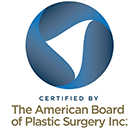
 |
    |
Capsular ContractureIdentifying and Correcting Capsular ContractureWhat is capsular contracture?Capsular contracture is the term used to describe scar tissue that can form around breast implants which may cause the breasts to harden, may cause the breasts to look or feel different, and may cause some discomfort from the tightening of the capsule. Capsular contracture is an unpredictable complication, but it is also the most common complication following breast augmentation. Although presently we do not know what causes a capsular contracture to form in one woman and not in another, or why one breast may harden while the other remains completely soft and natural, there are some techniques that have reduced the risk in our patients.
This specimen photo shows the intact capsule containing the breast implant immediately after removal from the breast (a complete capsulectomy).
How can the risk of capsular contracture be reduced?Under the muscle placement (subpectoral or partially submuscular) of the implant reduces the risk of capsular contracture to approximately 8- 12% over your lifetime. Over the muscle (in front of the muscle, submammary or subglandular) has a 12-18% chance of capsular contracture. Complete unders (totally submuscular or totally submusculofascial) provide even more protection, with your risk of capsular contracture being reduced to 4-8% over your lifetime. Massage may or may not help prevent capsular contracture formation. Although there are no good studies proving the effectiveness of this technique, many plastic surgeons do believe in massage. Dr. Revis believes in massage on an individual basis. He is not convinced that massage can help prevent capsular contracture formation, but he does believe that massage can help the breasts soften post-operatively, may hasten implant "dropping and fluffing" (implant settling into the pocket as the muscle relaxes and the implants descend into the proper position), and may also help reduce swelling and make a patient feel better faster post-operatively. Just like a massage at a spa, breast massage can loosen the muscles and make a patient feel better. The "no-touch" technique Dr. Revis believes in the no-touch technique. In this method, the sterile package containing the implants is opened only at the moment they are ready to be inserted into the body. No one else handles the implants except Dr. Revis. He resterilizes the skin of the breasts with betadine, redrapes the operative field surrounding the breasts with new sterile towels, and replaces his own gloves. He washes the surface of his new gloves to remove any powder, and only then will he touch the implants. When the implants are inserted into the body, he takes care not to allow the implants to touch any instruments, the skin of the patient, or any sterile drapes surrounding the operative field. In this manner, there can be little chance of surface contaminants on the implants once they are inside the body. All of these measures help ensure that no foreign substances attach themselves to the implant, which could inflame the surrounding tissue and cause complications such as capsular contracture. Closed filling system (when saline implants are being used) Dr. Revis also believes that a closed filling system reduces the potential for capsular contracture. With this technique, the saline used to fill your implants flows from a sterile bag through sterile tubing into the sterile implant. There is no possibility of foreign bodies or bacteria or fungus entering the implants. How is capsular contracture diagnosed?A capsular contracture is usually diagnosed on physical examination by a plastic surgeon. You may notice that one or both of your breasts are not as soft as they once were or may actually begin to harden, your breasts may begin to look or feel different, or you may experience some discomfort from the tightening of the capsule. The appearance of any of these signs should alert you to the need to have your breasts examined by a plastic surgeon at your earliest convenience. Your plastic surgeon will examine you to determine if indeed you have a capsular contracture. The examination of each breast is classified on a scale of I to IV:
Can capsular contracture be seen on a mammogram?It is often possible to visualize the thickened capsules radiologically with a mammogram, ultrasound or MRI, although this is not necessary for the diagnosis to be made. The photos below demonstrate a patient who had silicone implants placed 25 years previously and presented to my office with bilateral ruptured silicone implants and capsular contractures. The image on the left represents the entire breast (hazy black), capsule (gray) and implant (white). The image on the right is a closeup of the capsule surrounding the implant.
What treatment methods are available for capsular contracture?Zafirlukast (Accolate)Zafirlukast (brand name: Accolate) taken twice a day for 90 days has been shown to result in a softening of the scar tissue around the implants in approximately 50% of cases. Forty randomly chosen patients with capsular contractures were given zafirlukast (Accolate) and experienced dramatic softening of the breasts over 3-6 months. In another study, thirty patients with capsular contractures used Accolate for 12 months and 50% experienced softening of the breasts. Accolate has also been shown to decrease the recurrence of capsular contracture in patients undergoing capsulectomy. If you have a capsular contracture, Dr. Revis will most likely recommend a trial of Accolate before considering surgical intervention. If you are having a surgical capsulectomy, then Dr. Revis will likely recommend a short course of Accolate pre- and post-operatively. Suggested dose: 20mg Zafirlukast twice daily for 3 months. The same dose is used for preventive treatment 2 weeks prior to surgery. Risks: Allergic rashes. Long term effects are unknown as Zafirlukast has only been available in the US since 1999. Other benefits: Zafirlukast is also used for chronic rhinitis, so patients may notice improved breathing and decreased snoring. Capsulectomy (complete removal of the scar capsule)For those patients without significant softening during a trial of Accolate, the only other effective alternative is to completely remove the scar tissue surrounding the implant. Although this does not eliminate the possibility of future scar tissue forming around the implant, it does reduce the risk of subsequent capsular contracture when compared to other methods. Other methods which have fallen out of favor with most surgeons include capsulotomy (which means only a scoring or breaking up of the scar tissue, not complete removal), or a closed capsulotomy (where the surgeon squeezes the breast so hard that there is actually an audible popping noise from the scar tissue breaking open) which is rarely performed anymore because it almost always fails, may break your implants, may cause internal bleeding around the implant, and probably invalidates your warranty.
The fact that the capsule appears to spring open demonstrates the considerable compressive forces exerted on the implant by the thickened capsule. This is why capsular contracture often leads to increased firmness of the breast.
A close-up view of the cut edge of the capsule, demonstrating the thickening that occurs during capsule formation. A normal capsule is a flimsy, transparent structure. As thickening occurs, collagen is laid down in layer upon layer, ultimately becoming apparent as a change in the shape of the breasts, a change in the softness of the breasts, and in some cases causing pain.
The final photo in this series shows the capsule fully opened with the implant removed. Breast Augmentation Revision Main Page Please call (954) 630-2009 for further information or to schedule your complimentary consultation. Email: DrDonRevis@hotmail.com
|
||||||
|
|
Copyright 2022 South Florida Plastic Surgery Associates |